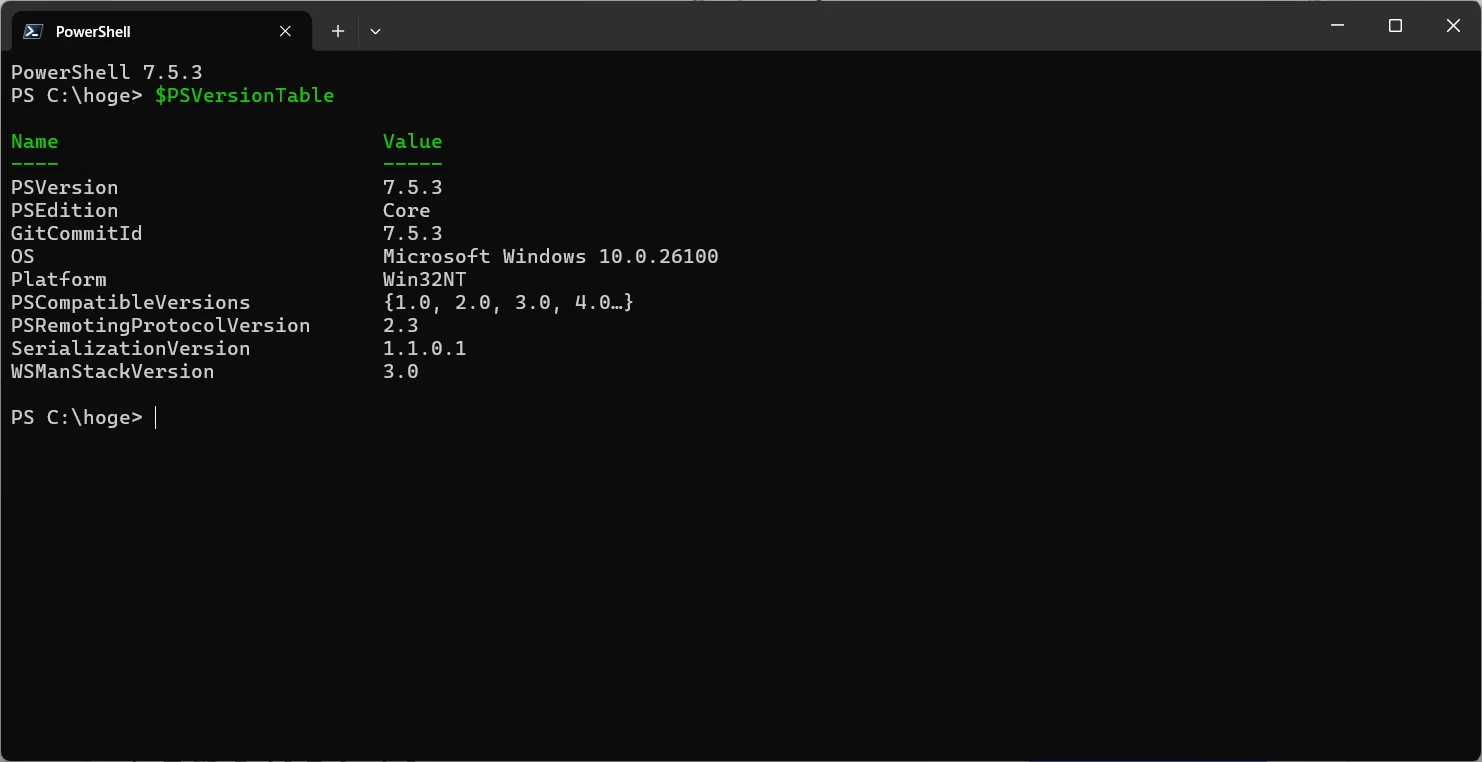WSL (Windows Subsystem for Linux)
Table of Contents
-
- 4.1. Checking installed distributions
- 4.2. Running Linux distributions
- 4.2.1. Default User
- 4.2.2. Default Distribution
- 4.3. Stopping Linux distributions
-
- 5.1. Installing Distributions
- 5.2. Exporting Distributions
- 5.3. Importing Distributions
- 5.4. Removing Distributions
-
- 6.1. Creating a PostgreSQL Server
- 6.1.1. Installing PostgreSQL
- 6.1.2. Setting a password for the postgres user
- 6.1.3. Allowing external connections
- 6.1.4. Connection check
- 6.1.5. Connecting from an external program
- 6.2. Creating an Oracle Server
- 6.2.1. Installing Podman
- 6.2.2. Getting Oracle Database image
- 6.2.3. Starting the container
- 6.2.4. Checking Oracle startup
- 6.2.5. Connecting from an external program
- 6.1. Creating a PostgreSQL Server
Introduction
WSL (Windows Subsystem for Linux) is a feature that allows you to run a Linux environment directly on Windows. It enables the use of Linux command-line tools and applications on Windows without the need for dual-booting or traditional full-spec virtual machines.
Features of WSL's lightweight virtual machine
- Users do not need to be aware of the virtual machine: WSL is integrated with Windows, so you don't need to manually start or stop the VM.
- File system integration: Files can be easily exchanged between Windows and Linux.
- Automatic resource management: WSL uses memory and CPU as needed, unlike VMs with fixed allocations.
- Fast startup: Due to its lightweight VM nature, startup is fast.
- Integration with Windows: The file system is integrated with the host OS, Windows, allowing mutual access and editing of files.
Personally, I consider its lightweight nature to be the biggest advantage. It's easier and quicker to set up a Linux environment compared to building one with traditional virtual machines, so it should be very useful for development when a Linux environment is needed.
Installation
How to install Linux on Windows with WSL
Execute the following command from PowerShell.
wsl --install
Enter your username and password to complete the process.
In the example below, korochin is entered as the username.
PS C:\hoge> wsl --install
Installing: Ubuntu
Ubuntu has been installed.
Launching Ubuntu...
Installing, this may take a few minutes...
Please create a default UNIX user account. The username does not need to match your Windows username.
For more information visit: https://aka.ms/wslusers
Enter new UNIX username: korochin
New password:
Retype new password:
passwd: password updated successfully
Installation successful!
To run a command as administrator (user "root"), use "sudo <command>".
See "man sudo_root" for details.
Welcome to Ubuntu 22.04.3 LTS (GNU/Linux 5.15.153.1-microsoft-standard-WSL2 x86_64)
* Documentation: https://help.ubuntu.com
* Management: https://landscape.canonical.com
* Support: https://ubuntu.com/advantage
This message is shown once a day. To disable it please create the
/home/korochin/.hushlogin file.
korochin@koro-P6-I7G60:~$
WSL File System
WSL's Linux file system and the host OS's Windows file system are seamlessly integrated, allowing you to browse folders and files in the Linux file system with Windows Explorer and edit files with Windows applications.
Additionally, access to the Windows file system from Linux is possible, with Windows drives mounted as /mnt/c/ and /mnt/d/.
You can view the entire Linux system's files from Windows Explorer at the following path:
\\wsl.localhost\Ubuntu
From within WSL, you can open the current directory in Windows Explorer using the following command:
explorer.exe .
The actual Linux file system is a single virtual disk file, which is created at the following path: (For the Ubuntu distribution created during the initial WSL installation)
%LOCALAPPDATA%\Packages\CanonicalGroupLimited.Ubuntu_79rhkp1fndgsc\LocalState\ext4.vhdx
Starting and Stopping Distributions
Checking installed distributions
If Windows is restarted, WSL's Linux will be stopped.
wsl --list --verbose
or
wsl -l -v
PS C:\hoge> wsl -l -v
NAME STATE VERSION
docker-desktop Stopped 2
* Ubuntu Stopped 2
The one marked with * is the "default distribution".
Running Linux distributions
wsl [--distribution, -d <distribution name>] [--user, -u <username>]
--distribution, -d
Runs the specified distribution. --user, -u
Runs as the specified user.
Example:
wsl --distribution Ubuntu --user korochin
wsl -d Ubuntu -u korochin
Default User
If the username is omitted, it will run as the "default user". The default user is the user created when the distribution was first installed.
wsl -d Ubuntu
PS C:\hoge> wsl -d Ubuntu
korochin@koro-P6-I7G60:/mnt/c/hoge$ whoami
korochin
The default user is registered in the Windows Registry 1. Instead of directly modifying the registry, you can change the default user by adding the following lines to /etc/wsl.conf, which is a better approach.
# /etc/wsl.conf
[user]
default=default_username
Default Distribution
If the distribution name is omitted, the default distribution will be executed.
wsl -u korochin
If both the username and distribution name are omitted, it will "start the default distribution with the default user".
wsl
To change the default distribution, use the following method:
wsl --set-default <distribution name>
Stopping Linux distributions
Use the following command to stop a distribution. The distribution name cannot be omitted.
wsl --terminate <distribution name>
PS C:\hoge> wsl --terminate Ubuntu
The operation completed successfully.
PS C:\hoge> wsl -l -v
NAME STATE VERSION
* Ubuntu Stopped 2
docker-desktop Stopped 2
The following command shuts down WSL. It terminates all running distributions and the WSL system.
wsl --shutdown
Managing Distributions
Installing Distributions
To install a new distribution, use the following command:
wsl --install <distribution> [--name <distribution name>] [--location <installation folder>]
Example:
wsl --install Ubuntu --name Ubuntu-hoge --location D:\wsl\ubuntu-hoge
A list of available distributions can be checked with wsl -l -o.
PS C:\hoge> wsl -l -o
The following is a list of valid distributions that can be installed.
Install using 'wsl.exe --install <Distro>'.
NAME FRIENDLY NAME
AlmaLinux-8 AlmaLinux OS 8
AlmaLinux-9 AlmaLinux OS 9
AlmaLinux-Kitten-10 AlmaLinux OS Kitten 10
AlmaLinux-10 AlmaLinux OS 10
Debian Debian GNU/Linux
FedoraLinux-42 Fedora Linux 42
SUSE-Linux-Enterprise-15-SP6 SUSE Linux Enterprise 15 SP6
SUSE-Linux-Enterprise-15-SP7 SUSE Linux Enterprise 15 SP7
Ubuntu Ubuntu
Ubuntu-24.04 Ubuntu 24.04 LTS
archlinux Arch Linux
kali-linux Kali Linux Rolling
openSUSE-Tumbleweed openSUSE Tumbleweed
openSUSE-Leap-16.0 openSUSE Leap 16.0
Ubuntu-20.04 Ubuntu 20.04 LTS
Ubuntu-22.04 Ubuntu 22.04 LTS
OracleLinux_7_9 Oracle Linux 7.9
OracleLinux_8_10 Oracle Linux 8.10
OracleLinux_9_5 Oracle Linux 9.5
openSUSE-Leap-15.6 openSUSE Leap 15.6
If --location is omitted, a folder with a GUID assigned to each distribution will be created under %LOCALAPPDATA%\wsl, and the distribution will be installed there.
Since --install downloads the distribution every time, it is faster to use import (described later) if you want to create multiple identical environments.
Exporting Distributions
wsl --export <distribution> <filename> exports a distribution to a tar file.
wsl --export Ubuntu ubuntu.tar
Importing Distributions
Import a tar file to create a new distribution.
The second argument of --import (the target folder for virtual disk creation) cannot be omitted.
wsl --import Ubuntu-2 D:\wsl\ubuntu-2 ubuntu.tar
Using the --vhd option, you can directly import a virtual disk file to create a new distribution. This method is faster than importing a tar file, so it is recommended if you want to duplicate a distribution.
wsl --import Ubuntu-3 D:\wsl\ubuntu-3 --vhd D:\wsl\ubuntu-2\ext4.vhdx
Removing Distributions
wsl --unregister <distribution name>
The distribution name cannot be omitted.
Application Examples
Creating a PostgreSQL Server
1Installing PostgreSQL
sudo apt update
sudo apt install postgresql
sudo service postgresql start
2Setting a password for the postgres user
Initially, the postgres database user does not have a password set.
A password is required for external connections, so set one.
sudo -i -u postgres psql
ALTER USER postgres WITH PASSWORD '<password>';
\q
3Allowing external connections
Edit pg_hba.conf to configure the authentication method for external connections (scram-sha-256: password authentication).
Add the following line to /etc/postgresql/16/main/pg_hba.conf.
Note: This setting (0.0.0.0/0) applies to all addresses, so be careful.
host all all 0.0.0.0/0 scram-sha-256
Edit postgresql.conf to accept external connection requests.
Add the following line to /etc/postgresql/16/main/postgresql.conf.
Note: This setting allows connections from all addresses, so be careful.
listen_addresses = '*'
Restart the PostgreSQL server to apply the settings.
sudo systemctl restart postgresql
4Connection check
Check the IP address of the virtual machine.
ip addr
Example:
korochin@koro-P6-I7G60:/mnt/c/hoge$ ip addr
1: lo: <LOOPBACK,UP,LOWER_UP> mtu 65536 qdisc noqueue state UNKNOWN group default qlen 1000
link/loopback 00:00:00:00:00:00 brd 00:00:00:00:00:00
inet 127.0.0.1/8 scope host lo
valid_lft forever preferred_lft forever
inet 10.255.255.254/32 brd 10.255.255.254 scope global lo
valid_lft forever preferred_lft forever
inet6 ::1/128 scope host
valid_lft forever preferred_lft forever
2: eth0: <BROADCAST,MULTICAST,UP,LOWER_UP> mtu 1500 qdisc mq state UP group default qlen 1000
link/ether 00:15:5d:25:a7:cd brd ff:ff:ff:ff:ff:ff
inet 172.24.25.30/20 brd 172.24.31.255 scope global eth0
valid_lft forever preferred_lft forever
inet6 fe80::215:5dff:fe25:a7cd/64 scope link
valid_lft forever preferred_lft forever
- lo:
10.255.255.254/32This is a special address WSL uses for internal communication. It cannot be used as an IP address. - eth0:
172.24.25.30/20172.24.25.30is the IP address of the virtual machine. This address may vary depending on the environment.
Let's try connecting by specifying the IP address.
sudo -i -u postgres psql -h 172.24.25.30 -U postgres
Enter the password to connect.
Here, the password was set to postgres.
korochin@koro-P6-I7G60:/mnt/c/hoge$ sudo -i -u postgres psql -h 172.24.25.30 -U postgres
Password for user postgres:
psql (16.10 (Ubuntu 16.10-0ubuntu0.24.04.1))
SSL connection (protocol: TLSv1.3, cipher: TLS_AES_256_GCM_SHA384, compression: off)
Type "help" for help.
postgres=#
If the postgres=# prompt appears, the connection is successful.
5Connecting from an external program
Connect to the PostgreSQL server from a C# program on the Windows host.
dotnet add package Npgsql
using Npgsql;
var connectionString = "Host=172.24.25.30;Port=5432;Username=postgres;Password=postgres;Database=hoge";
using var connection = new NpgsqlConnection(connectionString);
connection.Open();
connection.Close();
Creating an Oracle Server
The distribution used for verification was OracleLinux 9.x.
1Installing Podman
sudo dnf install -y podman
2Getting Oracle Database image
sudo podman pull container-registry.oracle.com/database/free:latest
3Starting the container
If the password is not strong enough, startup will fail.
Here, the password was set to Ora23c#Hoge.
sudo podman run -d --name oracle23c \
-p 1521:1521 \
-e ORACLE_PWD=Ora23c#Hoge \
-v oracle_data:/opt/oracle/oradata \
container-registry.oracle.com/database/free:latest
4Checking Oracle startup
Enter the oracle23c container running with Podman using a bash shell.
podman exec -it oracle23c bash
Connect with sqlplus.
sqlplus system/Ora23c#Hoge@localhost:1521/FREE
If a prompt like the following appears, it's successful.
SQL*Plus: Release 23.0.0.0.0 - Production on Mon Oct 13 07:30:43 2025
Version 23.9.0.25.07
Copyright (c) 1982, 2025, Oracle. All rights reserved.
Last Successful login time: Mon Sep 22 2025 06:26:57 +00:00
Connected to:
Oracle Database 23ai Free Release 23.0.0.0.0 - Develop, Learn, and Run for Free
Version 23.9.0.25.07
SQL>
5Connecting from an external program
Connect to the Oracle server from a C# program on the Windows host.
dotnet add package Oracle.ManagedDataAccess.Core
using Oracle.ManagedDataAccess.Client;
var connectionString = "User Id=system;Password=Ora23c#Hoge;Data Source=172.24.25.30:1521/FREE;";
using var connection = new OracleConnection(connectionString);
connection.Open();
connection.Close();
References
Official: Windows Subsystem for Linux documentation
Footnotes
-
Inside
HKEY_CURRENT_USER\Software\Microsoft\Windows\CurrentVersion\Lxss, a GUID is assigned to each distribution, and the DefaultUid value is the UID of the default user (usually 1000).↩

